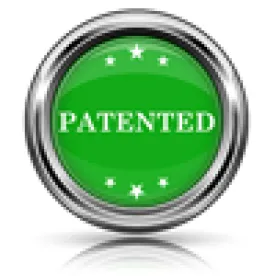In its Decision, the Board denied institution of inter partes review of claims 1-17 of U.S. Patent No. 8,766,298. The ’298 patent relates to an encapsulating material for a light emitting diode (LED).
As an initial matter, the Board determined that no claim terms required an express construction for the purposes of its decision. Next, the Board considered the asserted grounds of unpatentability. It began by considering Petitoner’s argument that a limitation referred to as “the 50-micron limitation ‘effectively removes [an] innate physical property of fluid encapsulants from the public domain” and, thus, cannot preserve the validity of the challenged claims.’” The Board stated that “Petitioner does not provide a specific explanation or identify specific evidence showing that a fluid encapsulant innately forms a meniscus or dome with a top surface that is within about 50 microns of a top surface of an LED package” and noted that “the ’298 patent indicates that conventional encapsulants do not form a meniscus or dome with a top surface that is within about 50 microns of a top surface of an LED package.” Accordingly, the Board was not persuaded.
The Boarad also was not persuaded that using “the terms ‘very slight,’ ‘moderate(ly),’ or ‘modest’ dome interchangeably when referring to a domed meniscus of 50 microns or less” created “an equivalence between the descriptors ‘very slight,’ ‘moderate,’ or ‘modest,’ and the specific measurement of the 50-micron limitation.” Accordingly, it was not persuaded that “the disclosure of a very slight, moderate, or modest meniscus in the prior art teaches or suggests the 50-micron limitation.” The Board then considered whether claims 1, 3-6, 8-9, 11-14, and 17 would have been obvious over applicant-admitted prior art (AAPA). Petitioner argued that “the top surfaces of the encapsulants in Figures 1 [which is AAPA] and 3 ‘are identical in curvature and maximum departure from the top surface of the package,’” and, “as a result, Figure 1 of the ’298 patent teaches the 50-micron limitation of the challenged claims.” In response, Patent Owner argued that Figures 1 and 3 “are not drawn to scale and, thus, cannot be used for a dimensional comparison” and that the ’298 patent indicates that the meniscus of Figure 3 differs from that of Figure 1. The Board agreed with the Patent Owner that “Petitioner has not shown sufficiently that AAPA teaches the 50-micron limitation.” Thus, it found that Petitioner was not reasonably likely to prevail on this ground.
Next, the Board considered whether claims 1-10 and 12-17 would have been obvious over Asakawa. Petitioner argued that Figure 2B of Asakawa “shows a meniscus that is substantially similar to the meniscus in AAPA.” The Board, however, agreed with Patent Owner “that Petitioner has not shown sufficiently that Asakawa teaches the 50-micron limitation.” In particular, the Board found that “Petitioner does not identify any teaching in Asakawa that the top surface of the meniscus in Figure 2B is within about 50 microns of the top surface of the LED package,” that “Petitioner’s comparison of Figure 2B of Asakawa to AAPA is not persuasive because Petitioner does not provide a specific explanation or identify specific evidence showing that Figure 2B of Asakawa is drawn to scale,” and that “Petitioner has not shown sufficiently that the meniscus in AAPA teaches the 50-micron limitation.” Accordingly, the Board concluded that Petitioner had not demonstrated a reasonable likelihood of prevailing on this ground.
Finally, the Board considered Petitioner’s argument that claims 1–17 would have been obvious over AAPA or Asakawa in view of Sorg, Matsubara, Uemura, Shimizu, Waitl, or Asakawa. The Board was not persuaded by Petitioner’s arguments that Sorg shows a “slight or very slight meniscus,” that Matsubara and Uemura shows “a moderate or modest dome,” or that Waitl “shows a meniscus that is substantially similar to the meniscus in AAPA.” For each of these arguments, the Board found that Petitioner had not identified “any teaching” that “the top surface of the dome . . . 2 is within about 50 microns of the top surface of the LED package” and did not “provide a specific explanation or identify specific evidence showing that [the cited figure] is drawn to scale.” Accordingly, the Board determined that Petitioner did not demonstrate a reasonable likelihood of prevailing on this ground.
The Board therefore denied the Petition.
Kingbright Electronics Co., Ltd. v. Cree, Inc., IPR2015-00748
Paper 8: Decision Denying Institution of Inter Partes Review
Dated: August 10, 2015
Patent: 8,766,298 B2 Before: Kevin F. Turner, Benjamin D.M. Wood, and Robert J. Weinschenk
Written by: Weinschenk
Related Proceedings: Cree, Inc. v. Kingbright Electronics Co., Ltd., No. 14-cv-621 (W.D. Wis.); Cree, Inc. v. Harvatek Corp., No. 14-cv-620 (W.D. Wis.); Cree, Inc. v. Honeywell International Inc., No. 14-cv-737 (W.D. Wis.); and Cree, Inc. v. Feit Electric Co., Inc., No. 15-cv-22 (W.D. Wis.); In re Light-Emitting Diode Products and Components Thereof, Inv. No. 337-TA-3051 ; IPR2015-00747



 />i
/>i

